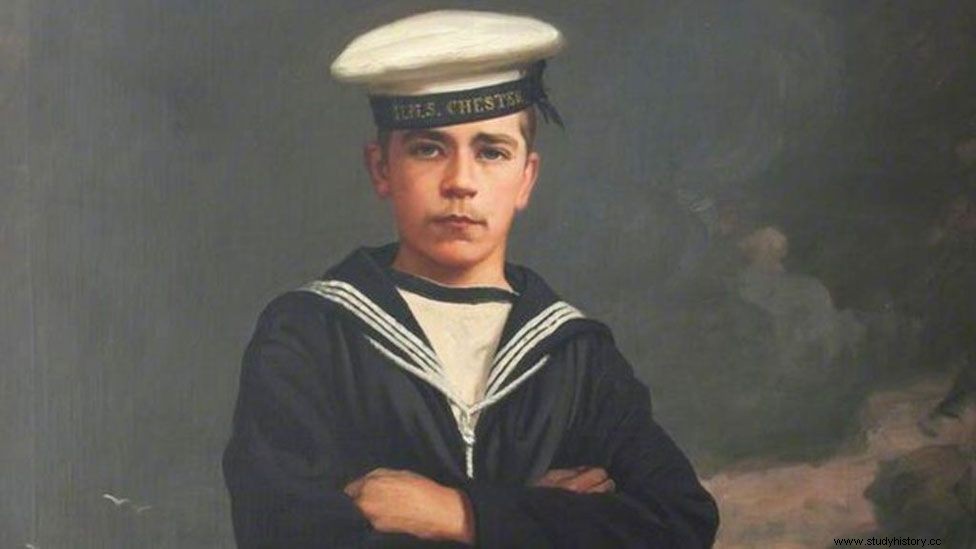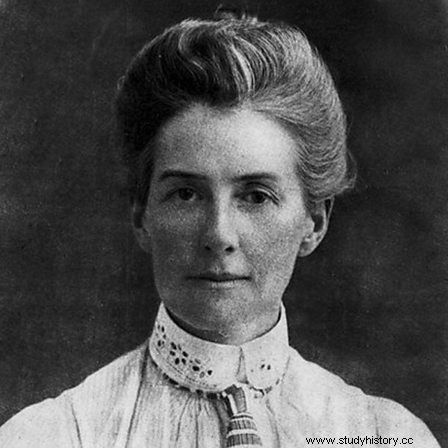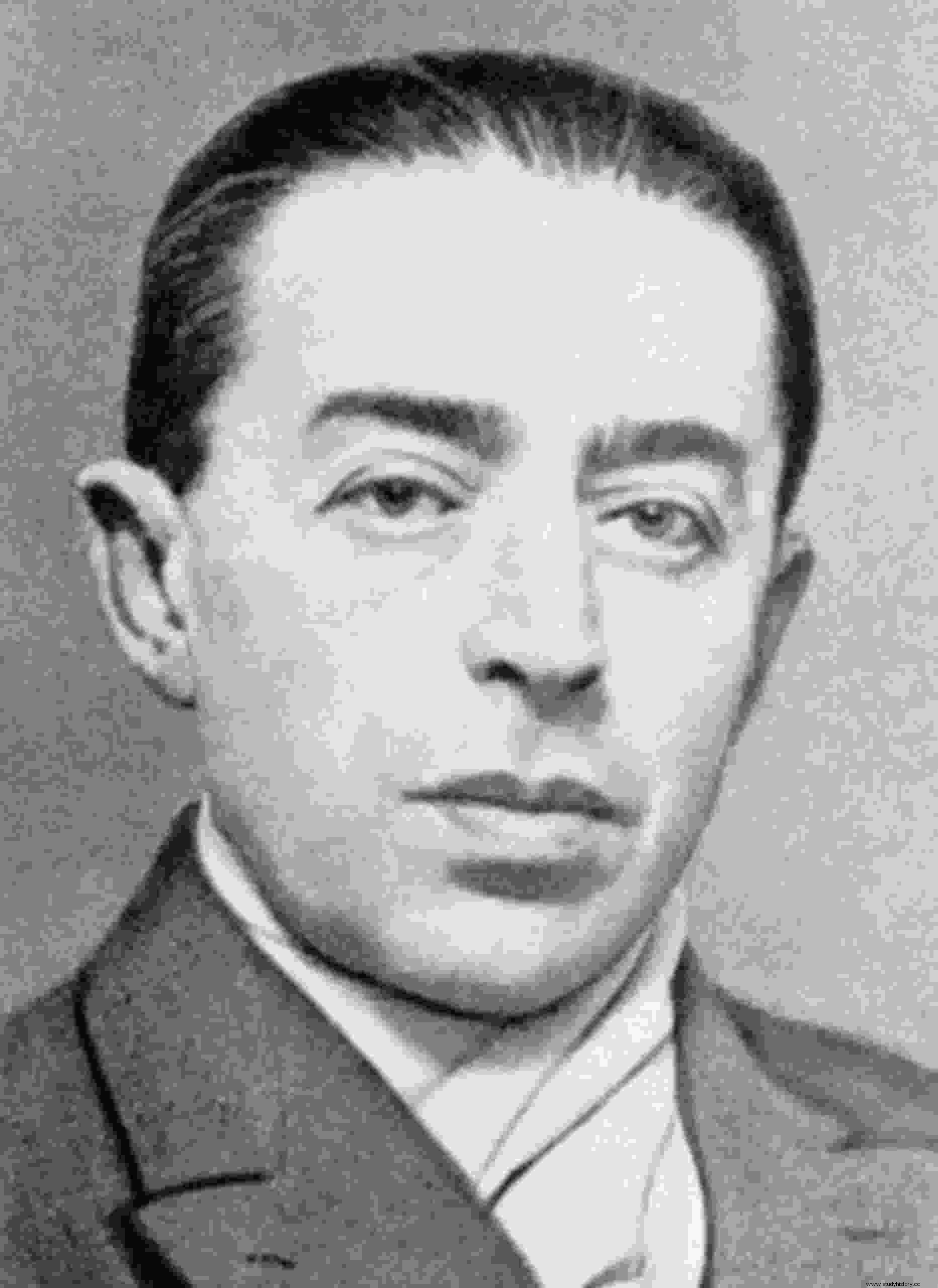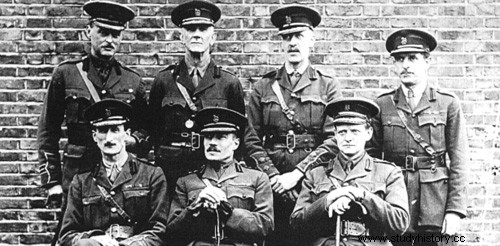MI5's mission is to keep the UK safe. The release of their top-secret files proves how they have done since the First World War.
On Thursday, April 10, 2014, to mark the 100th anniversary of World War I (WWI), MI5 made top secret files from WWI available online.
They included information about spies and heroes, even suspected communists, whom MI5 kept under surveillance for the first few years.
The Scouts

In 1908, British Lieutenant General Robert Baden-Powell published Scouting for Boys, a manual that promotes good citizenship and self-confidence. This eventually led to the Boy Scout movement.
Its popularity grew, not just in the UK, but worldwide. Boys and young men were given useful skills, such as field crafts, signaling, and sailing, which proved useful when World War I broke out.
In 1914, the Boy Scout movement was active for six years.
The older scouts and their leaders joined the Armed Forces. At the same time, men left their jobs that had to be done by the remaining civilians. Baden-Powell wondered how his scouts could contribute to the war effort.
While not in a military role, Baden-Powell saw that his scouts could do their part to support important services.
Coast Guard
One of the scouts' guard duties involved supporting the coast guard. It was crucial for them to look at the coast, harbors and estuaries to detect a German invasion.
Although under the command of their patrol leaders, the Coast Guard monitored them and the scouts handled their own activities and actions.
Their duties included coastguard, sending signals and delivering messages.
Naval scouts first undertook these tasks since they specialized in water-based activities. As the word spread, other Scout groups volunteered.
Their other duties included guarding railway crossings, telegraph and telephone cables, water reserves and other places of military importance from the sabotage of the enemy.
Breeding
Many volunteered to work on farms, especially around harvest time.
Originally, men employed in the countryside did most of the work by hand. However, many of them left to join the Armed Forces, which jeopardized the harvest. As this is known, the scouts undertook to undertake some of the farm work.
Some Scout troops from urban areas even changed the schedule for the summer camp to work on the farms instead.
The scouts did not just grow food. For example, linen produced a tough canvas that was used for jobs such as making tents and covering wings.
In August 1914, in rural France, an impending German invasion prompted French peasants to fight. When the crop was not collected, the country was facing food shortages. An appeal sent across the channel asked for help with the harvest. Many scouts sent letters offering help.
Cabin and ambulance fun
The scouts had a strong desire to help the Armed Forces. Since they were too young to join the army, they found new, innovative ways to raise money.
For example, a Cub Pack spent an entire day collecting acorns, which were used for animal feed, and selling them. Another example is when the scouts in Belfast collected and sold bottles and raised NOK 600.
With the money raised, the scouts bought ambulances that served as far as the Middle East.
In collaboration with charities and using the funds they collected, the scouts bought and supported the operation of cabins at army camps in Belgium, France, Italy and the United Kingdom. They provided refreshments and entertainment.
All in all, they created a place for soldiers to relax when they were away from the front.
Messengers
In 1914, only a few homes and public buildings owned telephones. Because of this, the scouts became budg boys.
Being a budget boy was an important job. The hand-delivered letters and telegrams, the most important methods of communication.
The scouts were stationed at government offices, police stations and other places where messages were quickly conveyed and had to be delivered.
To be a messenger, it was crucial for scouts to be healthy, reliable, and have a good sense of direction.
First Aid
One of the earliest skills a Scout learns is first aid.
Scouts helped and cared for the sick and injured men in the Armed Forces and civilians who were taken in the attacks. They worked as stretchers and performed basic first aid.
Jack Cornwall
John Travers Cornwall (January 8, 1900 - June 2, 1916), also known as Jack Cornwall and Jutland Jack, was a young sailor and one of the youngest to be awarded the Victoria Cross during World War I.
He loved the outdoors and became a Boy Scout at the age of 14. He received many badges and even rescued a girl who was stuck in a drain.
When World War I broke out in 1914, he applied for the Navy but was rejected due to his young age.
On July 15, 1914, he tried again without his parents' permission and with references. The Navy accepted his application.
Trained as a weapons lawyer or 'sight setter', he learned to aim weapons at targets, obey orders and work as part of a ship's crew.
After completing his training, he joined HMS Chester on May 2, 1916, with 400 sailors. They sailed to the North Sea to fight against approaching German ships.
On 31 May 1916, British sailors spotted German ships off Jutland in Denmark. The cannons opened fire and the battle of Jutland began. HMS Chester was under fire from four German ships, hit by several grenades (large missiles). The shooting crew was injured or killed.
Jack was the only one left standing. In pain, when the grenades hit the ship, he stood by his pistol waiting for orders.
When rescuers found him, the flying metal splinters hurt him terribly. HMS Chester returned to port and Jack was taken to the hospital.
The doctors sent for his mother, but before she arrived, Jack died on June 2, 1916.
He was only 16 years old.
The Aftermath
The story of Jack Cornwall spread throughout the nation. The pistol he manned remains at the Imperial War Museum in London.
He received the Victoria Cross Medal for his service to the Navy and outstanding bravery.
The Cornwall badge, still issued today, is the highest award for a scout's bravery.
Britain recognized the bravery of the home front scouts and the armed forces. Former Scouts were awarded 21 Victoria Crosses, the highest military award for bravery "in the face of the enemy" to members of the British and Commonwealth Armed Forces.
Edith Cavell

A British nurse, Edith Louisa Cavell (4 December 1865 - 12 October 1915), took up a position as a matron in Belgium's first training hospital and school for nurses.
At that time, there was no established nursing profession in Belgium. Ultimately, her revolutionary work led her to become the founder of modern nursing education in Belgium.
In 1914 she was in Norfolk visiting her mother when the war broke out. After hearing about the threat to Belgium from advancing German troops, she felt it was her duty to help the wounded and the fallen.
She immediately returned to Brussels.
On August 20, 1914, the Germans occupied Brussels and Cavell remained in her post. The nursing school became a Red Cross hospital. She treated the injuries on both sides and still treated civilians.
From Belgium to Neutral Netherlands
In September 1914, after the Battle of Mons, Cavell helped two wounded British soldiers trapped behind German lines. She made sure that they were smuggled out of Beligum to the neutral Netherlands.
After that, she became part of a network that provided shelter to Allied soldiers and Belgians who had qualified for military service and arranged their escape.
In 11 months, she helped 200 British, French and Belgian soldiers. They were hospitalized and treated. Later, the network made sure that guides led the soldiers to the borders.
Arrest and execution
In August 1915, German authorities arrested her. They accused her of helping British and French prisoners of war, and the Belgians who wanted to serve with the Allied armies escape to neutral Holland.
During the trial, she pleaded guilty to the offenses charged against her.
German authorities sentenced her to death. The diplomats of the neutral American and Spanish authorities tried to reverse her sentence, but their efforts were in vain.
On October 12, 1915, she confided in Pastor Horace Graham of the American Legation:
They have all been very kind to me here. But this I will say, as I stand as I do with God and eternity in mind, I realize that patriotism is not enough. I must not have any hatred or bitterness towards anyone.
At Tir National (Brussels shooting range) she was executed by the shooting team.
Legacy
Although her execution was legal under international law, it led to an increase in anti-German sentiment in the United States (United States) and the United Kingdom.
Cavell became a heroic martyr and was honored with a statue on St. Martin's Place. Moreover, she became a symbol of the Allied cause.
After the war, her body was exhumed and escorted to Britain. A memorial service was held at Westminster Abbey and reburied in Norwich Cathedral.
An Allied journalist wrote:
What Jeanne d'Arc had been for centuries for France, that of Edith Cavell for future generations of Britons.
Mata Hari

Margaretha Geertruide Zelle (August 7, 1876 - October 15, 1917) was a dancer, courtesan and alleged spy from the Netherlands.
In 1902 she left the Netherlands for Europe, where in 1905 she found fame in Paris as a striptease performer of Asian-inspired dancers.
While touring Europe, she told the story of how she was born in a holy temple and a priestess taught her ancient dances. The priestess gave her the name 'Mata Hari', which means 'eye of the day' in Mali.
However, Margaretha Zelle was born in a small town in Holland. She acquired knowledge of Indian and Javanese dances when she lived in Malaysia with her ex-husband.
No matter how false her authenticity was, crowds filled the dance halls and opera houses from Russia to France. The main reason was that her show consisted of her slowly stripping naked.
Practitioner and courtesans
Her abundance of charm and fluency in several languages made her a notorious courtesan.
When WWI broke out, she seduced the wealthy and the powerful from several nations. Her list of lovers included high-ranking military officers from the many nations.
One of her lovers was Major Arnold Kalle, a German military attaché.
Arrest in France
In February 1917, the French authorities arrested her for espionage and placed her in the St. Lazare Prison in Paris.
In her five-month military trial, French authorities accused Mata Hari of revealing information about the Allies' new weapons, the idea. As a result of this revelation, 50,000 French soldiers died.
However, her trial must have been filled with bias and circumstances.
There was no specific evidence or explanation that provided evidence that she was the direct cause of the victims. She claimed innocence
Controversy over her arrest
It is highly possible that the French authorities, after the French army suffered on the western front, used her as a scapegoat or distraction. They even called her "the greatest female spy of the century".
There is some evidence to suggest that she acted as a German spy and for a time a double agent for the French. The Germans dismissed her as ineffective and brought little intelligence of little value.
One report said that Major Kalle either viewed Mata Hari as a nuisance or a responsibility. He tried to get rid of her with a code he knew the French were cracking. The message he transmitted easily identified Mata Hari as a spy.
Implementation
On October 15, 1917, dressed in a blue coat and a three-cornered hat, she arrived at the execution site in Paris with a minister and two nuns.
After saying goodbye to them, she slowly walked to the designated place.
She turned to the firing squad, waved her blindfold and kissed the soldiers.
The many shots were fired as one and killed Mata Hari in an instant.
According to a report, she did not blow a kiss. She did not move a muscle.
She spent months enduring malnutrition and imprisonment under pest-infected conditions. The Dutch government did not intervene after the verdict.
Rumors circulated that the French executioners fired a shot, which allowed her to escape.
The truth was that her remains were donated for dissection to a medical school at the University of Paris.
Time author Ray Cavanaugh:
Despite all the demands her body had previously inspired, no one wanted it when she died.
Whether she was a spy or not remains a mystery.
Sidney Reilly

Not much is known about Sidney George Reilly, other than that he was possibly born in Odessa, the Russian Empire in 1874.
All that is known is his business as an adventurer and spy for Scotland Yard's Special Branch, which gave him the name "Ace of Spies".
While a legend of early British intelligence espionage, he is also the inspiration behind Sir Ian Flemin's titular character, James Bond.
His early life
Little is known about Reilly's early life. His allies knew as much about him as his enemies, which was very little. Even his wife was unaware of his true origins.
He claimed to have been born of an Irish sea captain or priest, or a land-owning, aristocratic Russian colonel.
In addition, he also claimed that his birth name is Georgi and he attended a chemistry course in Vienna. He returned to Odessa for his mother's funeral.
Based on his story, during the ceremony, the uncle revealed that young Georgi was the product of an affair between his mother and Dr. Rosenblum, the Jewish doctor who treated her.
Shameful, Georgi took the doctor's name, forged his death and stowed away aboard a ship bound for South America.
On the ship, he claimed to have rescued three British officers on an expedition into the Amazon. They offered to travel to England in gratitude.
Most of his stories are lies, and there are no documents to support his claims.
Recent evidence suggests that the doctor was his uncle.
Scotland Yards Special Branch
In 1895, in France, Reilly was suspected of murdering an anarchist for a large sum of money. He fled to London and used the stolen fortune to open a factory to produce quack medicine.
His companies caught the attention of William Melville, head of the Special Branch.
Reilly maintained a wide network of contacts among Russian and European Jewish immigrants. They were a valuable source of information on radical and revolutionary politics.
The Special Branch gave him a new British passport stating that he was born in Ireland as Sidney George Reilly. With his new identity, he returned safely to Russia.
Reilly in Russia
While in Russia, he joined the staff of a merchant, Moisei Akimovich Ginsburg. He was a supplier to the Russians and a war profiteer.
For four years, Reilly's position was ideal for studying the conditions and politics of the region.
Ginsberg maintained a private intelligence network, which Reilly probably joined.
The Russo-Japanese War
The stories say that Reilly played a role in the Japanese naval victory at Port Arthur. This victory was "one of the unsolved mysteries of the Russo-Japanese War".
At the time, he was a double agent serving the British and Japanese, both against Russia.
He and an accomplice stole Russian defense plans and the Russian floodlights mysteriously turned off when the Japanese fleet sailed into the harbor on February 8, 1904.
Two months later, Japanese troops shelled the remnants of the Russian navy and broke the Russian Empire's presence in China.
Sidney Reilly disappeared again.
Additional Utilities
Reilly continued to work for the specialist department.
A mission meant that he returned to Russia in November 1918 to support and spy on the monarchist white armies in the Russian Civil War.
With his background, he had no problem fitting into the staff of General Anton Denikin, one of the most successful white officers.
Reilly was able to see everything.
However, Denikin's mission began to fail. Reilly asked to return to the UK, as it would be a waste of time to stay longer.
He returned to London, received the Military Cross and traveled to New York.
OGPU and Reilly's death
On a mission, Reilly was well inside Soviet territory.
He soon realized that it was a stabbing operation carried out by OGPU, the predecessor of the KGB.
They captured him, and at first Reilly answered the interrogators with a rocky stubbornness.
It was not until they subjected him to a false execution that frightened him enough to sign a confession.
On November 5, 1925, the OGPU placed Reilly in a sack, drove him east of Moscow and shot him on the side of the road.
Although historians are unable to distinguish between the lies and the truth in Reilly's life, his reputation is still strongly held among members of the intelligence community.
the conclusion

MI5 continues its mission to keep the UK safe.
As seen from their surveillance of the past, they kept track of their heroes, spies, and enemies during World War I.
In marking the 100th anniversary of the First World War, they found a way to ensure that their country remembered the heroes and deeds that helped the war effort.
The true soldier does not fight because he hates what is in front of him, but because he loves what is behind him.
GK Chesterson.
